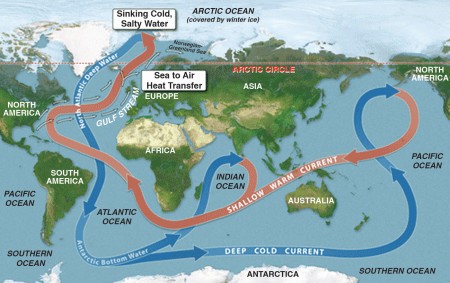October 20, 2015 – There is nothing exact about predicting what will happen as atmospheric temperatures rise. That’s scary. And that is the subject of a new collaborative report from researchers in the United Kingdom, France, the Netherlands and Germany. Entitled, “Catalogue of abrupt shifts in Intergovernmental Panel on Climate Change climate models,” it states “one of the most concerning consequences of human-induced increases in atmospheric greenhouse gas concentrations is the potential for rapid regional transitions in the climate system.”
What is meant by rapid transitions? Remember in the movie, “The Day After Tomorrow” when the world within a very short period descended into a new ice age? Well we are not talking about that type of extreme change. But we are talking about 37 “tipping points” of which 18 could happen even before the mean global temperature rises by 2 Celsius, the IPCC’s “safe limit.”
What are some of these tipping points?
- abrupt shifts in Arctic sea ice.
- Greenland ice melt accelerates.
- Melting of Himalaya glaciers.
- West Antarctic ice sheet collapses.
- ocean circulation patterns disrupted.
- increased Arctic permafrost melt with methane release.
- Amazon rainforest die back from prolonged drought.
- Northern boreal forest die back from prolonged drought.
- prolonged El-Nino in the Pacific Ocean.
- disruption of the annual Indian Ocean monsoon.
Note that many of these tipping points are phenomena occurring at a distance from major population centres. But the implications to those population centres is not diminished by the global impact of these sudden or rapid changes.
In “The Day After Tomorrow” a sudden change in water temperature in the North Atlantic triggers changes leading to cold Arctic air descending as far as the tropics in the form of several massive cyclonic storms. That scenario is not likely. But there is a concern that as Arctic Ocean sea ice diminishes that disruption to ocean currents in the North Atlantic, including the Gulf Stream, could occur. Evidence of disruption is already noted in the overturning circulation of ocean water in the Atlantic. The conveyor belt that draws warm water north and that causes cold saltwater to sink to the bottom appears to be weakening. One simulation indicates that from the 2020s onward we could see wild variations in temperatures for several decades because of changing North Atlantic ocean circulation patterns.
A caveat, the climate modeling is just that. And scientists agree that no model is a perfect simulation of real world conditions which raises an additional question. Could we be missing other tipping points that we have yet to consider because we have yet to model them?
As nations gather in preparation for the Paris climate talks each is pledging to reduce greenhouse gas emissions to try and keep temperatures from rising above 2 Celsius. Concerns that the pledges to date are not good enough to achieve the end result is disturbing enough. But now, if these latest abrupt climate change tipping points are added to the mix, it appears we are in for a rough ride in coming decades.






















